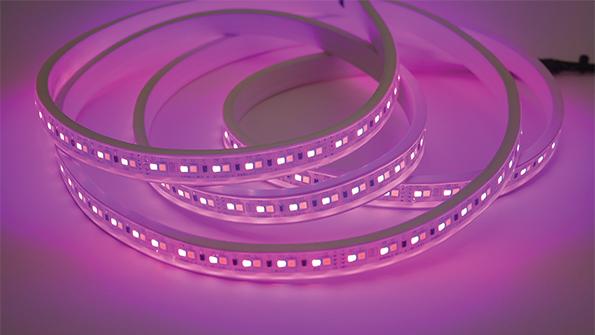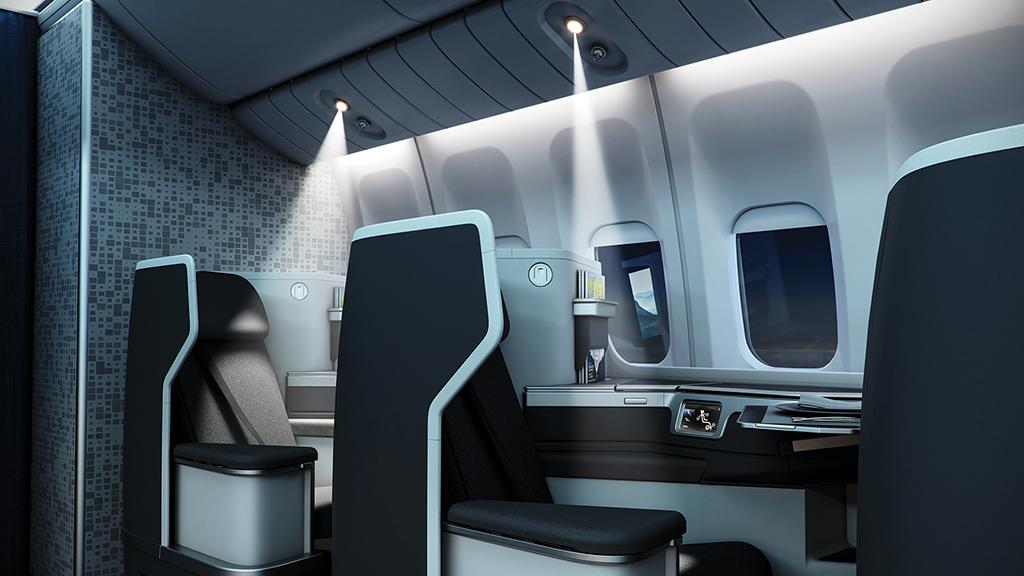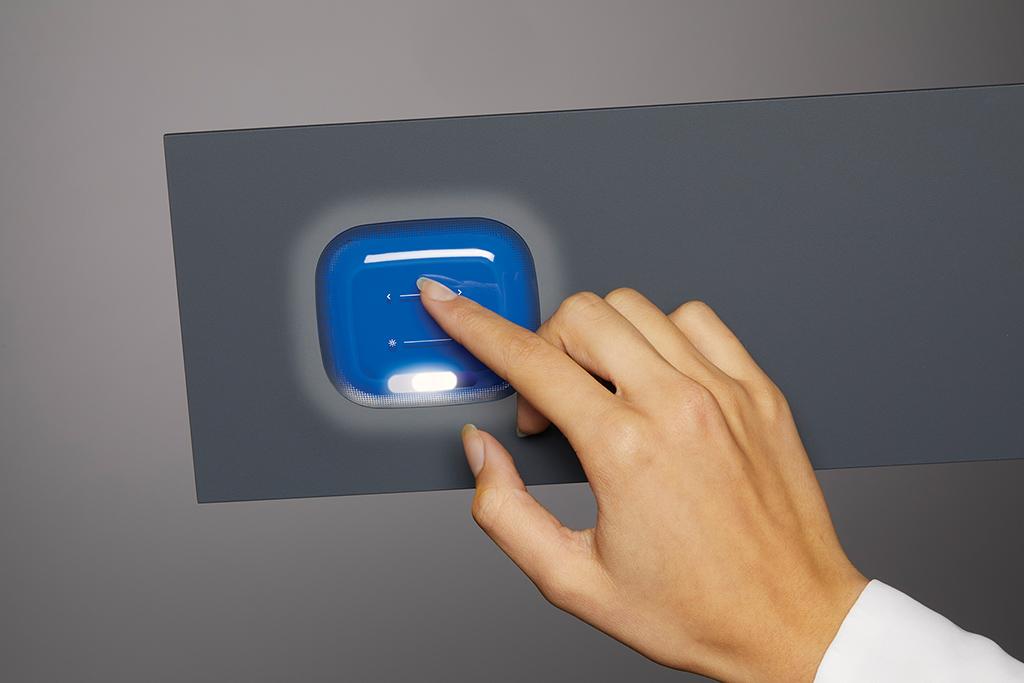
Cabin lighting is getting smarter, smaller and more lightweight, efficient and versatile, largely due to advances in LED technology, which continues to evolve.
As Nathan Kwok, vice president of marketing for Safran Cabin points out, LED lights made a step-change improvement over previous fluorescent tubes, reducing weight by about 40%. “As this technology continues to mature, the next step is to improve the appearance and quality of the light itself, making it appear more natural, as well as improving longevity and color stability,” he says. “At the same time, we are studying ways to make entire panels glow, diffusing light over very large areas to reduce eye fatigue and create even more interesting branding possibilities for our customers.”
In fact, LED is the key enabler of dynamic lighting, which was first applied to a commercial airliner with the introduction of the Boeing 787. This was a significant improvement over mood lighting, first installed on the 777 in the early 2000s, according to Melanie Kimsey-Lin, Boeing associate tech fellow, airplane product development. “While mood lighting added an LED accent light to fluorescent lighting for color, there was not much control,” she explains. “It is fully integrated in terms of electronics and software, which you can control to meet your requirements.”
Dynamic lighting also provides greater control over color and light, and how that plays with the cabin architecture. “You have more control over where the light will go. With mood lighting, it’s more of a wash,” says Brenna Wynhof, Boeing regional director for cabin marketing.
She predicts that as the airlines recover from the pandemic, there will be more single-aisle aircraft deployed in long-haul markets. “The result will be a shift toward more lighting flexibility and customization on single-aisle aircraft, to create a twin-aisle experience for passengers. I think that dynamic lighting will become standard on single-aisle aircraft.”
Matthew Opisso, value stream leader for lighting solutions at Collins Aerospace, reports that LED technology continues to mature, resulting in higher-quality light output, greater durability, and decreased component weight and size. Today’s systems are 10 times brighter than previous generations and are very reliable, he says. “In fact, the reliability of the latest generation of LEDs continues to build on that foundation—further reducing required maintenance and replacement costs compared to legacy lighting systems.”
Pushing the technology continues to target size—even though, as Opisso explains, LED lights take up a minimum amount of cabin real estate, which he says can quickly add up and affect fuel consumption. “This is why we are creating lights that are smaller still. As those lights get smaller, so do their attached circuit boards,” he stresses.

The latest LED technology utilizes highly efficient and miniaturized components, similar to those used in today’s televisions and phones. That, combined with “less intensive supporting components,” can yield a 25% weight reduction—at a minimum—compared to previous-generation systems, Opisso says.
He points out that new-generation LEDs are also demonstrating up to three times longer life compared to original generations, with reduced aging. “LED technology also offers a service life at least 50,000 hr. more than fluorescent systems, which leads to much less replacement or maintenance support,” he says.
At the same time, there are “greater levels” of lighting control and software advancements, including multiple zone breaks, scene settings and pixel-level controllability, coupled with lower power requirements. “These control features, combined with the advanced efficiencies of smaller, more powerful LEDs, greatly reduce the electrical demands on the aircraft,” he says.
The three latest examples of Collins’ LED technology include the Collins Viu flexible lighting system, the Secant luminous panel and the micro-LED reading light.
Viu, which rolled out in 2016, is a full-color-spectrum cabin lighting product that “conforms seamlessly” to tight corners or sweeping curves, giving airlines the capability to light every area of the aircraft, Opisso says.
“The Secant luminous panel, introduced in 2018, utilizes micro-LED technology and is designed to immerse the passenger in the cabin environment and transform any surface in the aircraft into an illuminated, dynamic display,” Opisso explains. “It can be customized to display light, images, and video applications, as examples.”
The micro-LED reading light, announced in 2019, replaces three reading lights. Each beam is individually controlled, allowing passengers to adjust the shape and size of the beam. “The reading light provides significant weight savings over legacy systems, with a lifespan up to 40,000 hr. higher than standard reading lights,” Opisso notes.
Movable Light With Fingertips
In 2020, German glass and lighting OEM Schott launched its Jade reading light, developed in cooperation with design firm PriestmanGoode, that creates “a special atmosphere within a business- or first-class seat,” says Philip Fischer, vice president for aviation.
Jade is termed “smart” because it interlinks with cabin and seat scenarios. “For example, when you adjust the position of your seat, the light beam automatically follows. This is the type of innovation airlines are looking for,” says Fischer, noting that at year-end 2020, an international carrier (that Fischer declined to identify) awarded Schott its first contract for Jade.
Other features include the ability to direct the light beam and intensity via touch technology, essentially making the light beam movable with the fingertips. “We were able to narrow down the light beam to the perfect angle and precisely direct it to the area we really want illuminated such as your laptop or book you are reading,” Fischer says.
Jade, according to Fischer, is the first application of modern capacitive- touch technology to an aviation reading light, which Schott combined with fiber optics and LED technology. It is powered by white LEDs hidden beneath a glass cover, and the light beam is directed by thin fiber-optic light guides. “Jade’s glass surface is operated by touch, just like a smartphone,” he says. “To enable communication with cabin lighting or seat scenarios, we implemented a CAN [controller area network] bus as the interface.”

Costs for maintenance and repair can be reduced by up to 90% compared to traditional flex-and-stay reading lights, because the light has a sleek glass surface and no moving or tilting parts, Fischer says. For easy access, Jade can be installed and removed through the seat shell. “It is no longer necessary to ‘weave’ the light through the innards of the seat construction, saving a lot of time—and nerves,” he says.
Along with that, Jade apparently does not make excessive demands on an aircraft’s electrical system. “Generally, our lighting solutions have the average power consumption of modern reading lights or lighting solutions,” he says. “Along with Jade, we introduced a smart multi-light controller for our flexible HelioCurve LED strip used for ambient lighting. This controller optimizes efficiency and the respective power consumption.”
Two Trends
Advancements in LED technology are driving two trends in cabin lighting, explains Niels Dose, product sales and key account manager of base maintenance services for Lufthansa Technik (LHT). One is the use of homogeneous LED strips as accent lights in premium and first-class environments. The other is to allow passengers to individually control their own environments by setting their color preferences for the flight. “At the same time, we see increasing demand to bring chronobiologic lighting into aircraft cabins to avoid jet lag with the use of intelligent human-centric lighting controls,” he says.
Chronobiologic lighting, or lighting focused on the passenger’s circadian rhythm, is gaining traction. Lufthansa has implemented the technology in its Nice cabin management/inflight entertainment system on its newest long-haul Boeing and Airbus fleet. The software, developed by Jetlite of Hamburg, is available for both line-fit and retrofit, according to Jetlite Managing Partner Achim Leder.
“The impact of light to positively affect the body’s internal clock has been scientifically proven, not only when moving between time zones but also for passengers on early morning flights,” Leder says. “As an awareness of the effects of light on health and well-being grows, passengers will expect airlines to follow.”
Due to the variety of LED solutions from various suppliers, effective chronobiologic lighting can be implemented in nearly every type of airframe—from private jets to single- and twin-aisle commercial airliners.
“While the new technology is being implemented on both narrowbody and widebody aircraft of all major OEMs, we believe aircraft for long-range flights are in greater focus, as passengers spend more time in the cabin,” says LHT’s Dose. “Every new aircraft type is optionally equipped with the latest lighting technologies, so we expect to see that with the newest aircraft models such as the A350-1000 and the 777X.”
As for the impact new-technology lighting will have on maintenance, Dose says LHT does not anticipate a significant impact on serviceability. However, he cautions that MRO providers will need to adjust staff skills, as the new systems are often network-controlled infrastructures involving databases for the adjustments needed, which sometimes affects maintenance. “This is, of course, a challenge for MROs that are used to simple bulb changes and old-school troubleshooting,” he says.






